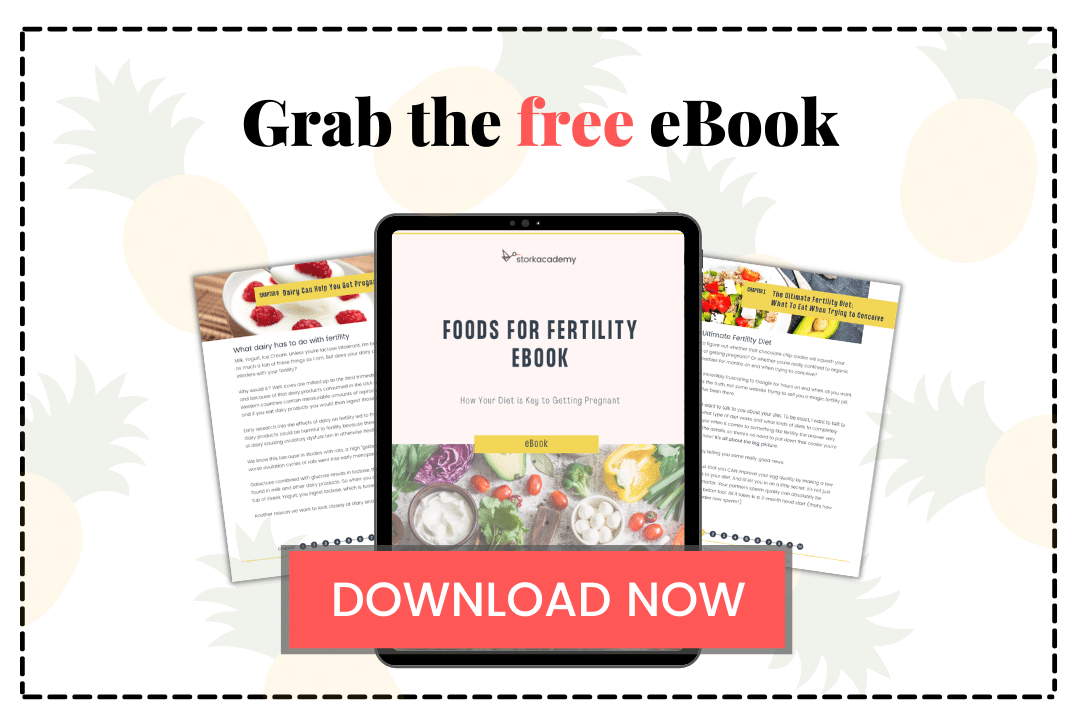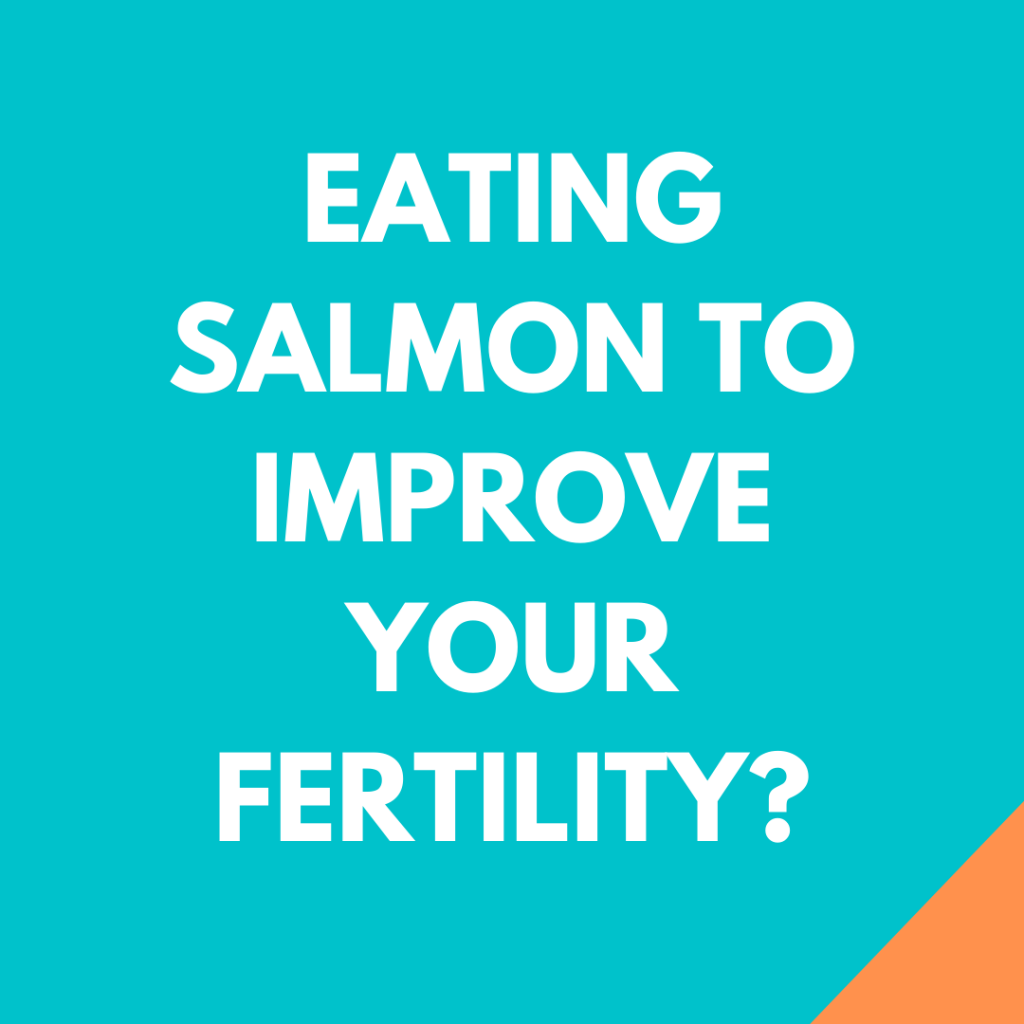We may earn a commission from affiliate links on this page.
Part 1. The Ultimate Fertility Diet: What To Eat When Trying to Conceive
Part 2. Meat, Poultry, Fish, Tofu: Which Protein is Best and Which is Worst for Fertility?
Part 3. Definitive Guide to Fats That HELP Fertility: Omega-3 and Other Fatty Acids
Part 4. Definitive Guide to Fats That HURT Fertility: Saturated Fats and Other Fats
Part 5. Sugar and Other Carbs Suck When Trying to Conceive
Part 6. Artificial Sweeteners When Trying to Conceive or Pregnant: Bad Idea?
Part 7. Two Reasons Coffee is Bad When Trying For a Baby
Part 8. Can I Drink Alcohol When Trying to get Pregnant?
Part 9. Dairy Can Help You Get Pregnant – Everything You Need to Know
Part 10. 10 Fertility Diet Tips to Implement Today
The quick win
Wait! Before you continue reading, consider doing ONE easy thing that is known to boost fertility: taking a daily high-quality prenatal multivitamin. This is without doubt the easiest way to boost your fertility (here’s why). Personally, I love the Smartypants prenatal gummy (because it’s good and tastes yummy) and the Nature Made prenatal vitamin with DHA (because it contains all kinds of goodies that boost fertility and is a trusted brand). (affiliate links)
What dairy has to do with fertility

Milk, Yogurt, Ice Cream. Unless you’re lactose intolerant, I’m betting that you’re as much a fan of these things as I am. But does your dairy addiction interfere with your fertility?
Why would it? Well, cows are milked up to the third trimester of pregnancy,1 and because of that dairy products consumed in the USA and other in Western countries contain measurable amounts of reproductive hormones,2 and if you eat dairy products you would then ingest those hormones!
Early research into the effects of dairy on fertility led to the idea that milk and dairy products could be harmful to fertility because there were some reports of dairy causing ovulatory dysfunction in otherwise healthy women.3
We know this because in studies with rats, a high “galactose” diet resulted in worse ovulation cycles or rats went into early menopause.4,5 That’s not good!
Galactose combined with glucose results in lactose, the main carbohydrate found in milk and other dairy products. So when you drink milk or eat a nice tub of Greek Yogurt, you ingest lactose, which is turned into galactose.
Another reason we want to look closely at diary and fertility is that women with a genetic disorder called galactosemia have trouble metabolizing galactose, and almost all women with galactosemia have greatly diminished ovarian reserves.6,7 So it appears that there is a link between dairy, or at least galactose build-up, and infertility.
To make matters more confusing, there is evidence that eating dairy could be beneficial to ovarian functioning!
For example, dairy intake is associated with lower risk of insulin resistance and type 2 diabetes,8 both of which have been associated with ovulatory dysfunction.9 Basically, eating more dairy could reduce your risk of diabetes, and, by extension, improve your ovulation.
In one study it was found that women who consumed three or more glasses of milk per day had a 70% lower risk of infertility compared to women who did not drink milk.10
Clearly we’re dealing with a complex issue here. If you want to improve your odds of conceiving, what do you do?
Let’s dive a little deeper!
The Nurses’ Health Study, dairy and fertility

Just like with carbohydrates and protein and many other aspects of diet and fertility, the Nurses’ Health Study took a deep look into the role of dairy.9,11 They set out to answer the question of whether dairy is actually beneficial or detrimental to fertility in women (not rats!).
Here’s what they found: the total amount of dairy consumption did not matter. But then the researchers took a separate look at low fat dairy (skim/low-fat milk, sherbet, yogurt, and cottage cheese) and high fat dairy: (whole milk, cream, ice cream, and cheese).
They found that adding 1 serving of low-fat dairy per day led to an 11% higher risk of infertility due to ovulatory problems. But adding 1 serving of high-fat dairy had a 23% lower risk of ovulatory problems.
In other words: low fat dairy was bad for fertility, and high fat dairy was good for fertility.
One possible explanation for this finding is that low and high-fat dairy have different estrogen concentrations,12 and this regulates something called Insulin Like Growth Factor 1, a hormone that’s associated with fertility.13
Oh and by the way, just like replacing meat protein with vegetable protein was the most beneficial for women over 32 years of age, eating more high-fat dairy is also more beneficial to the fertility of older women than it is to younger women.11
Is there really a difference in low fat vs. high fat dairy?

In a recent study, researchers wanted to shed more light on the association between dairy and fertility. They included more than 1,000 women from both Europe and the United States who were in the early stages of trying to conceive. They were followed for 1 year and after that year about two thirds had successfully gotten pregnant.
After crunching the numbers, the researchers found that dairy consumption was not particularly (at most slightly) related to improved fertility. They do, however, confirm that dairy consumption is not harmful to your fertility. Unlike the Nurses Health Study, they did not find any difference between consuming low and high-fat dairy.
Let’s just say that the jury is still out on whether there really is a difference between low and high fat dairy.
Evidence from IVF studies

Let’s talk about in vitro fertilization or IVF.
IVF studies can be super helpful when you want to learn something about fertility (not that surprising, eh?). That’s because IVF studies are conducted in a well controlled environment: women have the same problem (they can’t get pregnant), they all undergo the same treatment (a certain IVF protocol), and the studies are often well designed.
In IVF studies, the outcomes that are tested consist of:
- Whether an embryo has implanted (confirmed by ultrasound).
- Whether clinical pregnancy occurs (defined as a positive pregnancy test along with a heartbeat on ultrasound).
- Whether a live birth occurs.
This is also what researchers from Harvard set out to do.14 They tested whether dairy intake itself, and whether specific components of dairy such as calcium, are predictive on these three outcomes.
They found that in women undergoing IVF who consume a lot of dairy (the top 25% of dairy consumers) was linked to a 21% higher chance of a live birth compared to women with low dairy consumption.
But the most important finding of the study was that the live birth rate could be improved a lot in women 35 years or older. This mirrors the Nurses’ Health Study, which found that women over 32 could benefit the most from consuming high-fat dairy.
But unlike in the Nurses’ Health Study, this IVF study did not find any difference between full-fat and low-fat dairy foods.
Implications for women over 35

Taking the results of these studies together, this paints a really important picture for a group of women who already have a hard time getting pregnant: those older than 35.
If you’re slightly older and want to speed up conception, it is conceivable that increasing your dairy intake could be beneficial.
What’s more is that since implantation and pregnancy outcomes did not really improve with dairy intake, but live birth most certainly did, it is possible that dairy foods have a positive influence on maintaining pregnancy in older women.
And you know what, this makes a lot of sense! Just listen to this: drinking milk during pregnancy is associated with having a larger placenta and higher birth-weights too!15,16
The role of calcium

Here’s another aspect of diary that we should talk about: the effects calcium on a developing fetus (and on you!).
The main source of calcium is dairy consumption, but for a little developing fetus, the main source of calcium is you. Fetal bone development requires a certain level of calcium that the fetus will get from you. And calcium is one of those pesky essential nutrients that you must get through diet.
If you, when you’re pregnant, don’t consume enough calcium, unwanted things can happen. For example, calcium supplementation in pregnancy is linked to lower risk of preeclampsia and high blood pressure, and the odds of having a baby with low birth weight are also lower.17
And because of this added demand from the developing baby, your bone density will drop during pregnancy and while breastfeeding just to make sure the baby gets adequate supply of calcium. But this drop in your bone density will bounce back to normal.
There’s really no reason why you should not up your dairy intake. One way to get some extra calcium is by taking prenatal vitamins, which contain calcium. But prenatals don’t contain enough of it, so make sure you get it some other way too!
Most calcium rich foods are dairy based, for example, milk, yogurt and cheese, but if you’re lactose intolerant, there are many other ways to get sufficient calcium too. Kale, Broccoli, and Spinach. Some fish, such as sardines, are also high in calcium. And calcium fortified foods such as some orange juices are great options too.
Estrogens naturally occurring in dairy

Let’s talk a bit about hormones in dairy. I know this is a subject that comes up from time to time, so let’s take a quick look at what the evidence tells us!
Just like soy products contain something called phytoestrogens, so does dairy!
Phytoestrogens are plant-based compounds that mimic the estrogen sex-hormone, and therefore have the potential influence your reproductive system. Cows get this from eating grasses and pass on a bit of it on through their milk. Isoflavones -a subclass of phytoestrogen found in soy- is also present in dairy, as are other phytoestrogens such as lignan.
In a 2019 study from the United Kingdom, researchers found that isoflavone levels are highest in organic milk, and a good bit lower in conventional milk or free-range milk.18 And if you recall the previous chapter on soy, higher levels of isoflavones seem to be beneficial to couples undergoing infertility treatment.19 Which is great, but studies show that couples trying to conceive naturally (as in not using IVF) are unlikely to notice any positive effects on fertility.
And long term high intake of phytoestrogens such as isoflavones can have negative effects too… One study found that the endometrium, the place where the embryo implants, can become abnormally thick after years of high isoflavone consumption,20 and there are indications that very high isoflavone levels can interfere with ovulation too.21
Isoflavones from organic milk may help couples struggling with infertility, but it’s certainly not a magic bullet as it’s unlikely to be beneficial to the general population.
And in case you’re wondering whether to purchase skim or whole milk, it actually doesn’t matter since phytoestrogen levels are similar between the two,22 although as a general rule, high-fat milk is probably “better” for your fertility.
So if you want to boost isoflavone levels, stick to organic whole milk, otherwise, stick to regular or free-range milk.
The bottom line on dairy and fertility
First of all, if you consume dairy regularly, you’ll get a much needed dose of calcium and that’s really important for when you become pregnant.
And when it comes to fertility, dairy consumption is pretty likely to boost your chances of getting pregnant even if it’s just a little bit. The evidence is most clear in women undergoing IVF. But what is still unclear at this time is whether high-fat dairy is better than low-fat dairy, although one prominent study certainly suggests this is the case.
One final note: just to be safe, stick to milk that is labeled “rBST free”. This means that the cows aren’t treated with artificial growth hormones in order to produce more milk.
References
1. Daxenberger, A., Ibarreta, D., & Meyer, H. H. (2001). Human Reproduction Update, 7(3), 340–355.
2. Pape-Zambito, D. A., Roberts, R. F., & Kensinger, R. S. (2010). J Dairy Science, 93(6), 2533–2540.
3. Cramer, D. W., Xu, H., & Sahi, T. (1994). Am J Epidemiology, 139(3), 282–289.
4. Bandyopadhyay, S., Chakrabarti, J., Banerjee, S. et al. (2003). Human Reproduction , 18(10), 2031–2038.
5. Swartz, W. J., & Mattison, D. R. (1988). Fertility and Sterility, 49(3), 522–526.
6. Guerrero, N. V., Singh, R. H., Manatunga, A., B. et al. (2000). J Pediatrics, 137(6), 833–841.
7. Spencer, J. B., Badik, J. R., Ryan, E. L. et al. (2013). J Cli Endocrin and Metab, 98(7), E1257–E1265.
8. Pereira, M. A., Jacobs, D. R., Jr, Van Horn, L., S. et al. (2002). JAMA, 287(16), 2081–2089.
9. Tobias, D. K., Gaskins, A. J., Missmer, S. A. et al. (2015). Diabetologia, 58(4), 707–715.
10. Greenlee, A. R., Arbuckle, T. E., & Chyou, P.-H. (2003). Epidemiology , 14(4), 429–436.
11. Chavarro, J. E., Rich-Edwards, J. W., Rosner, B. A. (2007). Obstetrics and Gynecology, 110(5), 1050–1058.
12. Wolford, S.T., Argoudelis, C.J. (1979). J Dairy Sci, 62(9)m 1458-1463.
13. Magon, N., Malik, S., Agrawal, S. (2011). Indian J Endocrin and Metabol, 15(7), 246.
14. Afeiche, M.C., Chiu, Y.-H., Gaskins, A.J. et al. (2016). Human Reproduction, 31(3), 563-571.
15. Heppe, D. H. M., van Dam, R. M., Willemsen, S. P. et al. (2011). Ame J Clinical Nutrition, 94(2), 501–509.
16. Olsen, S. F., Halldorsson, T. I., Willett, W. C. et al. (2007). Am J Clinical Nutrition, 86(4), 1104–1110.
17. Beinder, E. (2007). Therapeutische Umschau. Revue Therapeutique, 64(5), 243–247.
18. Nørskov, N. P., Givens, I., Purup, S. (2019). Food Chemistry, 295, 1–9.
19. Unfer, V., Casini, M. L., Costabile, L. et al. (2004). J Soc Gynecol Invest, 11(5), 323–328.
20. Unfer, V., Casini, M. L., Costabile, L.. et al. (2004). Fertility and Sterility, 82(1), 145–148.
21. Jefferson, W. N. (2010). J Nutrition, 140(12), 2322S – 2325S
22. Antignac, J. (2004). Food Chemistry, 87,(2), 275–281.




